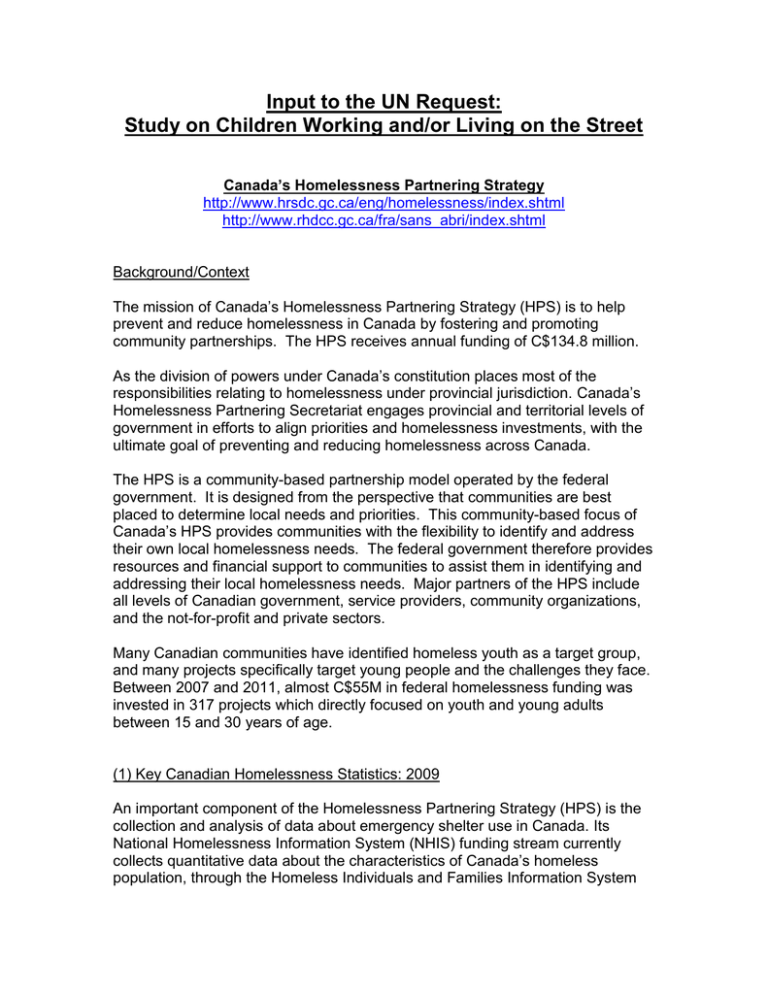Input to the UN Request:
advertisement

Input to the UN Request: Study on Children Working and/or Living on the Street Canada’s Homelessness Partnering Strategy http://www.hrsdc.gc.ca/eng/homelessness/index.shtml http://www.rhdcc.gc.ca/fra/sans_abri/index.shtml Background/Context The mission of Canada’s Homelessness Partnering Strategy (HPS) is to help prevent and reduce homelessness in Canada by fostering and promoting community partnerships. The HPS receives annual funding of C$134.8 million. As the division of powers under Canada’s constitution places most of the responsibilities relating to homelessness under provincial jurisdiction. Canada’s Homelessness Partnering Secretariat engages provincial and territorial levels of government in efforts to align priorities and homelessness investments, with the ultimate goal of preventing and reducing homelessness across Canada. The HPS is a community-based partnership model operated by the federal government. It is designed from the perspective that communities are best placed to determine local needs and priorities. This community-based focus of Canada’s HPS provides communities with the flexibility to identify and address their own local homelessness needs. The federal government therefore provides resources and financial support to communities to assist them in identifying and addressing their local homelessness needs. Major partners of the HPS include all levels of Canadian government, service providers, community organizations, and the not-for-profit and private sectors. Many Canadian communities have identified homeless youth as a target group, and many projects specifically target young people and the challenges they face. Between 2007 and 2011, almost C$55M in federal homelessness funding was invested in 317 projects which directly focused on youth and young adults between 15 and 30 years of age. (1) Key Canadian Homelessness Statistics: 2009 An important component of the Homelessness Partnering Strategy (HPS) is the collection and analysis of data about emergency shelter use in Canada. Its National Homelessness Information System (NHIS) funding stream currently collects quantitative data about the characteristics of Canada’s homeless population, through the Homeless Individuals and Families Information System (HIFIS) software and other non-HIFIS data collection systems. The HIFIS software is currently being used in 123 of Canada’s 397 emergency shelters. The goal of NHIS is to gather sufficient data for comprehensive analysis and provide a portrait of shelters and their use across Canada. This data will serve Canadian stakeholders, including service providers, researchers and multiple levels of government. Once compiled and analyzed, this information will: contribute to the development of a better understanding of homelessness in Canada; support improved policy development; and facilitate better planning and development of effective measures to prevent and reduce homelessness. For more information about the software, please visit the HIFIS Web site: http://www.hifis.ca/index-eng.shtml. (2) Projects / Good Practices The HPS supports community efforts and funds community priorities which are developed through a community planning process. In the previous round of community planning initiated in 2007, youth was the homeless sub-population most often mentioned among community priorities. In fact, nearly two-thirds of Canada’s medium and large communities specifically identified homeless youth as a target audience of their support interventions. This suggests that Canadian communities recognize and are committed to addressing issues related to youth homelessness. Many Canadian communities have also developed services that address the particular needs of young people. Some of these services include assistance to overcome barriers to employment, education and skills training, and access to income and housing supports. The HPS also provides grants and contributions to stakeholders and homelessness experts to conduct research, data analysis and identification of best practices through its Homelessness Knowledge Development stream. Some recent research projects focusing on homeless and at-risk youth include: o Funding a qualitative research project examining the ways in which street youth engage with the formal and informal economies. This research included in-depth interviews with street youth and service providers. It also developed an inventory of employment-based street youth programs across Canada. Findings suggested that the ability to maintain formal employment is dependent on the housing situation of individual youths. When formal work is scarce, homelessness presents an additional barrier to employment as employers are often reluctant to hire an individual who has no fixed address. o Funding the dissemination of Eva's Initiatives Reconnect Toolkit. This toolkit provides information on Eva's Initiatives successful Family Reconnect Program to communities interested in preventing youth homelessness. The 2 toolkit serves three purposes: it can inform counseling approaches for individual youth; it can help start conversations about family; and it can be used to develop new programs focused on early intervention and prevention for at-risk youth. As a result of the community partnership approach of the Homelessness Partnering Strategy, the Government of Canada contributes funding to various local initiatives which help to reduce homelessness at the community level. Some successful community initiatives include: o The Core Neighborhood Youth Co-op (CNYC) in Saskatchewan. The CNYC teaches young people work and life skills and helps them earn income. The Government of Canada helped transform an old building into a community centre for homeless girls which now allows CNYC to provide an expanded job skills and education program for girls, mostly 14 to 18 years of age, who have dropped out of school. Many are homeless. At the co-op young women are provided the opportunity to learn a trade, such as woodworking, bicycle repair, quilting, beadwork and sewing, while working toward completing high school. o Covenant House Vancouver. Various agencies are involved in helping Vancouver’s street youth get their lives back on track. One of the best-known is Covenant House, which serves close to 2,000 youth each year. Its Crisis Shelter program provides street youth a safe place to stay, food, medical attention and the opportunity to develop a plan to move away from the streets and into a better life. In January 2010, 32 new beds opened, bringing shelter capacity to 54 beds in total. The expansion was funded in part by an $800,000 contribution from the Government of Canada through the Homelessness Partnering Strategy. (3) Main Challenges A major challenge in addressing youth homelessness is that the homeless population can be difficult to survey, particularly homeless youth who may be less likely than older individuals to use emergency shelters. For a variety of reasons, many homeless youth avoid sleeping in emergency shelters and it is suspected that they account for a large share of the “hidden homeless” population. Reliable data on the “hidden homeless” population is therefore extremely difficult to obtain. Research indicates that the difficulties faced by many homeless youth are complex. About half of street youth arrive on the streets via group homes and/or foster care placements. Many have experienced family violence and are more susceptible to a variety of behavioral problems such as delinquency, prostitution, 3 substance abuse and mental illness.1 Specialized services are therefore required to assist youth who are homeless or at risk of becoming so. Difficulties in acquiring reliable detailed data about homeless youth and their specific needs make it particularly challenging to develop effective intervention strategies. To address this shortcoming, the Canadian government has undertaken research and various pilot projects to help identify the unique difficulties faced by homeless youth and highlight the types of policy interventions that appear to hold the most promise in helping to address these needs. Examples of research projects funded by the HPS were noted in section two. Some innovative pilot projects are highlighted in section five, below. (4) Access to Counseling Services Counseling services typically fall under provincial jurisdiction in Canada. The federal government therefore has very little direct involvement in the provision of these types of services. However, counseling services are often a major component of HPS-supported projects, and are frequently offered by community organizations that receive direct and indirect financial support from the HPS among their initiatives to address homelessness at the community level. (5) Innovative Approaches The HPS has developed numerous pilot projects with other federal partners to address youth homelessness through its Federal Horizontal Pilot Projects stream. These pilots test innovative solutions to address youth homelessness. Some recent examples include: o Providing youth with trades related skill development in St. John’s, Newfoundland. Partnering with Choices for Youth Inc., this project sought to reduce the incidence of housing instability and homelessness among youth in St. John’s by providing participants with basic math, literacy and carpentry skills, ultimately leading to employment with a construction team. The pilot project targeted 10 youths who had struggled to maintain healthy, independent living and who were living a high-risk lifestyle, which made many of them ineligible for traditional employment programs. Of the 10 youth participating in the program, none had successfully completed high school. Over the course of the pilot project, two received a General Educational Development (GED) certificate and four were in the process of completing one. Two participants received literacy tutoring, and eight had been conditionally accepted into post secondary education. Of the 10 youth, six self-identified as having existing addiction issues at the beginning of the 1Canada National Clearinghouse on Family Violence (2006). Family Violence and Homelessness: A Review of the Literature. Prepared by Sylvia Novac. Ottawa Public Health Agency of Canada. 4 program. All received counselling and/or treatment to assist them in their successful entry into the workforce. Overall, all 10 participants completed the program. o Helping homeless youth in Vancouver, British Columbia acquire life skills and housing. The pilot project served 154 individuals: 33 young women and 121 young males. Family Services of Greater Vancouver provided three, full-time housing support workers for homeless youth aged 19 to 24 to assess their needs, provided a range of life-skills training such as preparation for schooling or employment skills, assistance in securing housing and referral services. The goals of the pilot project included: offering youth greater opportunities to leave street life; helping them integrate into the community; reducing their exposure to health and safety risks; and acquiring increased independence. The participants indicated that, when given the opportunity to access meaningful services delivered in an accessible way, they will make use of them. The pilot project developed a series of recommendations to better support homeless youth, stressing: the importance of increasing the availability of housing and support services for homeless youth aged 19 to 24; the need to provide culturally-specific services; the necessity of focusing on mental health and addiction issues; and the benefits of helping improve life and social skills of homeless youth, through mentoring. o Testing the effectiveness of youth homelessness reduction strategies in three rural regions in Canada. This seven-month pilot project involved working with more than 300 homeless and at-risk young people between the ages of 12 and 24 to obtain key pieces of personal identification such as a Social Insurance Number, Health Card, and Birth Certificate, and acquire reliable contact coordinates such as an e-mail account or postal address. Assistance was also provided to: open a personal bank account and develop a money management plan; register for school or skills training; find a family physician; prepare a résumé; and apply for social assistance or social housing support, if needed. Objectives of the pilot project included: stabilizing a youth’s housing situation; providing additional education or employment skills; and securing key pieces of identification that are generally needed to access banking and social services. The project suggested promising results towards outcomes such as: decreasing the number of school drop-outs; increasing the number of youth with part-time jobs or regular volunteer hours; increasing the capacity of youth to maintain stable housing; and increasing the number of youth with a wellness plan. Specific outcomes: 226 participants (74 percent) obtained a health card; 151 (50 percent) obtained a Social Insurance Number; 86 (29 percent) setup a personal bank account; and 84 (28 percent) developed a job résumé. o Partnering with the Vancouver Organizing Committee for the 2010 Olympic and Paralympic Winter Games and RONA, a national chain of home and building supplies in Canada, in offering a 30-week carpentry skills and work 5 experience program designed for people who have had difficulty entering the workforce. The program provided 64 students with carpentry skills, training, and job experience. Trainees were Aboriginal people, inner-city residents, youth at risk of homelessness, and women at risk. The Government of Canada’s Homelessness Partnering Strategy provided financial support for the project. (6) International Efforts Canada is committed to advancing and protecting the rights of children and youth. Canada has long been supportive of the view that realizing children's rights, including those children and youth who are most marginalized, is essential to reducing poverty in a sustainable way. In 2009, five new Thematic Priorities were announced for Canada’s international assistance envelope: increasing food security; securing the future of children and youth; stimulating sustainable economic growth; promoting democracy; and ensuring security and stability. The Children and Youth Strategy has a focus on protecting the safety and security of children and youth. In order to advance the Children and Youth Strategy, Canada is working to: Strengthen and implement national protection frameworks to safeguard the human rights of children and youth and build capacity in the public sector to protect children and youth at risk of violence, exploitation and abuse, particularly girls; Ensure that schools are safe and free from violence and abuse and are child-friendly learning environments; and, Support efforts to create opportunities for youth-at-risk to find alternatives to violence and crime and to engage as positive members of society. Within this approach to securing the safety and security of children, Canada works to address issues facing children living/working on the street and street involved youth, both directly and indirectly. Indirectly, Canadian programming addresses the issues that contribute to the vulnerability of people at risk, such as poverty, discrimination, lack of education, and equality between women and men, and contributing factors such as poor governance, including low judicial, legislative and administrative capacity. More directly, Canada addresses these issues through a small number of projects dedicated to specific issues facing children living/working on the street and street involved youth, such as creating opportunities for youth at risk, youth 6 employment opportunities as well as addressing child protection, trafficking, child labour and sexual exploitation. In both cases, Canada recognizes the importance of children and youth participation in decisions that affect their lives. Canada promotes child and youth participation as a means to increase the effectiveness and sustainability in Canada’s efforts to ensure the safety and security of children and youth. Examples of these projects include: The Youth Venture Initiative: Harmonized Programs for Economic Opportunities ($246K) in Ethiopia, is a Street Kids International initiative. This initiative seeks to strengthen the capacity of youth serving organizations in Ethiopia to offer marginalized youth entrepreneurship training that will enhance their employment prospects. Through CIDA's International Youth Internship Program (IYIP), funded by Canada's Youth Employment Strategy (YES), CIDA also offers young Canadian post-secondary graduates the opportunity to gain professional experience through international cooperation work with Street Kids International. The Basic Education for Working Children - Phase II project, ($14M) provides funding to UNICEF to improve the basic competencies of urban working children so that they can pursue safer and better life options within a supportive environment that includes policy advocacy and networking. This project targets 200,000 urban working children in Bangladesh's six main urban centres, aged between 10 and 14 years, engaged in occupations that prevent them from attending school. Through the Elimination of the Worst Forms of Child Labour project ($499K), CIDA provides funding to the International Labour Organization (ILO). This project aims to prevent the recruitment of children and adolescents into the worst forms of child labour, as defined by the ILO, and to withdraw children who have already been recruited. The Labour Rights: Prevention of Labour Trafficking ($4M) project in China, that aims to reduce trafficking in women, children, and youths for labour exploitation in China in eight provinces. The Child Protection Surveillance Project in South Africa ($5.3M), which implements a five-year Study on Surveillance of Child Abuse, Neglect and Exploitation to increase the capacity of the South African Department of Social Development, and provincial and civil society partners in the provision of child protection services across South Africa. 7 The Youth Actions to Prevent Sexual Violence ($200K) aims to increase public awareness of sexual violence as a human rights violation, while also building the capacity of young people to develop youth-led education, prevention and advocacy initiatives to reduce the prevalence of sexual violence in Colombia. The Life Start: Program to Assist At-Risk Youth, project ($435K), aims to secure the future of at-risk youth in the city of Odessa, Ukraine through the establishment of an improved model of care for youth transitioning out of orphanages to independent living, including the establishment of a foster-care program for at-risk female youth. 8





